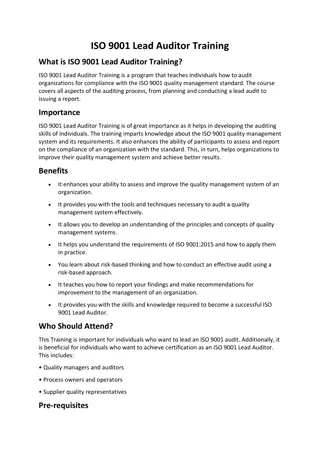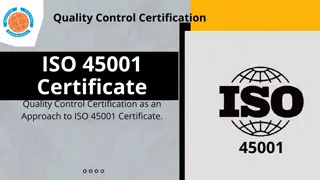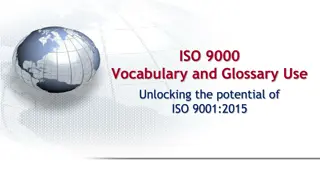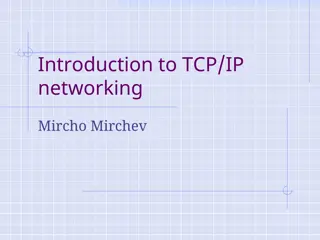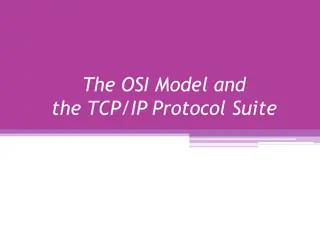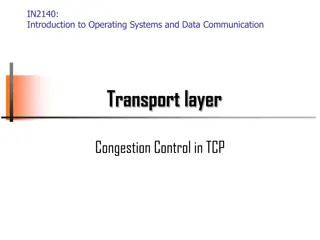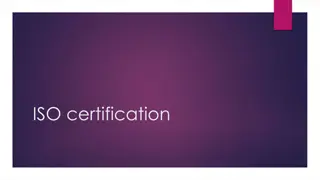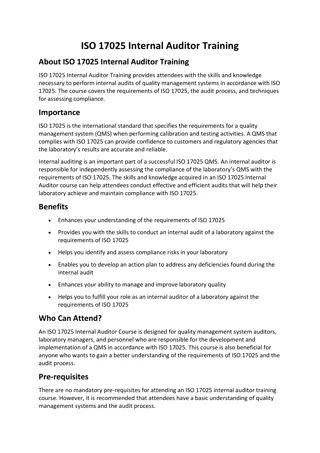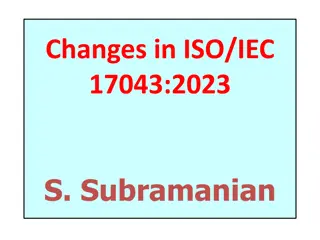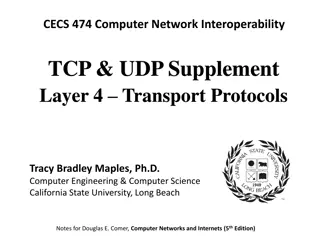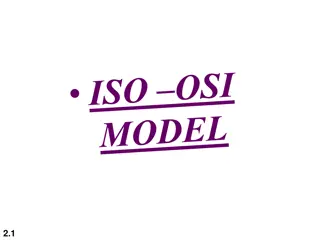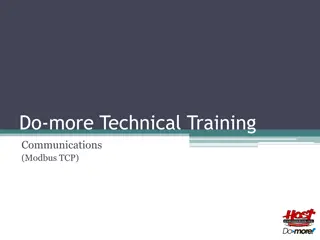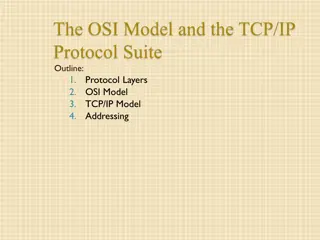
Understanding OSI Model in Telecommunications
Explore the OSI Model and its significance in telecommunications. Learn about the layers, communication strategies, international standards, and architectural communications outlined by the OSI Model for efficient network management and connectivity.
Download Presentation

Please find below an Image/Link to download the presentation.
The content on the website is provided AS IS for your information and personal use only. It may not be sold, licensed, or shared on other websites without obtaining consent from the author. If you encounter any issues during the download, it is possible that the publisher has removed the file from their server.
You are allowed to download the files provided on this website for personal or commercial use, subject to the condition that they are used lawfully. All files are the property of their respective owners.
The content on the website is provided AS IS for your information and personal use only. It may not be sold, licensed, or shared on other websites without obtaining consent from the author.
E N D
Presentation Transcript
OSI Model ISO ISO - - OSI OSI MODEL MODEL
OSI Model Strategy communicating Defines communication A A communication standard A A programmer by on Separating flexibility, the communication Strategy for communicating equipment Defines communication between communication architecture, standard for programmer formats by the on to Separating flexibility, for the communication devices for connecting equipment. . necessary between devices architecture, therefore, for the formats data the communication to the communication for example, entire devices. . connecting host host computers computers and and other other necessary elements devices. . elements for for data data therefore, defines hosts. . data in architecture and software. . communication example, we host defines a a the communicating communicating hosts in a a manner manner defined and passes defined passes it it communication architecture the communication communication software functions not need to functions need to to adds modify more adds more we do do not to modify entire host software software include include
OSI Model Layer It It is is easy layered The layered Network protocol The exchanged, handshake Layer architecture easy to layered architecture The network layered architecture Network layers protocol. . The protocol exchanged, and handshake between architecture simplifies to debug architecture network network management architecture. . layers follow simplifies the debug network network. . management is is easier the network network applications network design applications in design. . in a a easier due due to to the the follow a a set set of of rules, rules, called called protocol defines between layers defines the and the the format the control layers. . format of control and of the and timing the data timing for data being for the being the
OSI Model International established architecture Open model In reference standard Term two and International established a a committee architecture for Open Systems model is is the In 1984 reference model standard for Term open two systems and associated standard committee in for computer Systems Interconnection the result 1984, , the model was for communications open denotes systems which associated standards standard computer communication Interconnection (OSI) result of the Open was approved communications architecture denotes the which conform standards. . organization in 1977 communication. . organization 1977 to (ISO) an (ISO) to develop develop an (OSI) reference reference of this Systems Interconnection approved as architecture. . the ability conform to this effort effort. . Open Systems Interconnection (OSI) as an (OSI) an international international ability to to the to connect the reference connect any reference model any model
OSI Model The Architectural communications The makes as as on The moving network manageable This functions The OSI Architectural communications. . The OSI makes its as spreadsheets) as wire) on another The OSI moving information network medium manageable problems This separation functions is is known OSI model model is is now now considered model considered the model the primary inter primary computer for for inter- -computer OSI model its way spreadsheets) through wire) to another network OSI reference information between medium into problems . . separation into known as model describes way from to another network. . reference model describes how from application through a a network another application how information application programmes network medium application programme information or programmes (such medium (such programme located or data (such (such located data model divides between computers into SEVEN divides the computers over SEVEN smaller the problem smaller and problem of over a a and more of more into smaller as layering smaller more layering. . more manageable manageable
OSI Model The networking Each protocol Each or The physical flow The presentation orientated Data information transit The process networking into Each layer protocol specification Each layer or hardware The lower physical flow of The upper presentation and orientated more Data is is Encapsulated information as transit. . of breaking into layers layer provides specification. . layer communicates hardware on lower 4 4 layers Layers of data upper four more toward Encapsulated with as it it moves process of breaking up layers reduces provides a a service up the the functions complexity. . to the functions or or tasks tasks of of reduces complexity service to the layer layer above above it it in in the the communicates with on other layers (transport, Layers 4 4, , 3 3, , 2 2, , and data from four layers and session toward services with the the same same layer s layer s software software other computers (transport, network, and 1 1) ) are from end layers of session services to with the moves down computers. . network, data are concerned through the of the Layers to the the necessary down the data link network. . model (application, Layers 7 7, , 6 6 and the applications necessary protocol the layers link and with the and the concerned with the network OSI model applications. . end to to end end through the OSI (application, and 5 5) ) are are protocol network layers before before network
OSI Model Provides information Provides physical information. . physical interface interface for for transmission transmission of of Defines system medium Covers procedural Such voltage transmission other layer Defines rules system to medium. . Covers all procedural - - aspects Such characteristics voltage changes, transmission distances, other similar layer specifications rules by to another by which another on which bits on a a physical bits are physical communication are passed passed from communication from one one all - - mechanical, aspects for characteristics as changes, physical distances, physical similar attributes specifications. . mechanical, electrical, for physical as voltage physical data attributes are electrical, functional physical communication voltage levels, data rates, physical connectors, are defined functional and communication. . levels, timing rates, maximum connectors, and defined by and timing of maximum by physical of and physical
OSI Model Data communication Data link communication over link layer layer attempts over the attempts to the physical to provide physical layer provide reliable layer interface reliable interface. . Breaks reassemble Create Handle acknowledgement Implement Supports communication Supports communication Breaks the reassemble the Create and Handle acknowledgement and Implement flow Supports points communication. . Supports simplex, communication. . the outgoing the received and detect errors outgoing data received frames detect frame errors and retransmission flow control points- -to data into frames. . boundaries. . by retransmission scheme control. . to- -point into frames frames and and frame boundaries by implementing implementing an an scheme. . point as as well well as as broadcast broadcast simplex, half half- -duplex duplex or or full full- -duplex duplex
OSI Model Implements the Implements routing the network routing of of frames frames (packets) (packets) through through network. . Defines take Defines can Handles Facilitates networks The packet different Defines the take from Defines logical can be Handles congestion Facilitates interconnection networks (Internetworking) The network packet into different media the most from the logical addressing be identified congestion in interconnection between (Internetworking). . network layer into smaller media. . most optimum the source addressing so identified. . optimum path source to path the the destination so that the packet packet should should to the destination that any any endpoint endpoint in the the network between heterogeneous network. . heterogeneous layer also smaller packets also defines packets to defines how how to to accommodate to fragment accommodate fragment a a
OSI Model Purpose mechanism processes Purpose of mechanism for processes in of this for the in different this layer the exchange different computers layer is is to exchange of computers. . to provide of data provide a a reliable data between reliable two between two Ensures Ensures Ensures units Provides service Provides Multiplex channel Ensures that Ensures that Ensures that units. . Provides connectionless service. . Provides for Multiplex channel. . that the that data that there the data data units there is is no data units units are no loss units are are delivered loss or are delivered delivered in or duplication delivered error in sequence duplication of error free sequence. . of data free. . data connectionless or or connection connection oriented oriented for the multiple the connection multiple connection connection management connection over management. . over a a single single
OSI Model Session dialogue to between This established Any handled Session connection This which Session mechanism between from Session layer dialogue between to start, between applications This layer established on Any necessary handled by Session layer connection. . This layer which can Session mechanism such between checkpoints, from the layer provides between the start, control applications. . layer requests on an necessary log by this layer is is also provides mechanism the two control and mechanism for two end and end for controlling systems. . It It defines conversations (called controlling the defines how (called sessions) the how end systems end conversations sessions) requests for an end log- -on this layer also responsible for a a logical end- -user s on or layer. . responsible for logical connection user s request or password connection to to be be request. . password validation validation is is also also for terminating terminating the the layer provides can be layer such that checkpoints, all the last provides services be full layer that if if a a failure last checkpoint services like duplex or can all data checkpoint. . like dialogue or half also failure of data can dialogue discipline half duplex also of some can be discipline full duplex can duplex. . provide provide check some sort be retransmitted check- -pointing sort occurs retransmitted pointing occurs
OSI Model Presentation data communicating Also (cryptography) Presentation layer data is is to communicating entities Also handles (cryptography). . layer defines to be entities. . handles data defines the be exchanged the format between the format in in which the two which the the two exchanged between data compression compression and and data data encryption encryption
OSI Model Application programs Application to Examples as Application programs and Application layer to support Examples of as file interacts highest level contains management distributed applications of application file transfer, layer layer interacts with with of OSI application OSI model functions application model. . and is is the layer contains support distributed application layer transfer, electronic level of management functions applications. . layer are electronic mail, the highest are applications mail, remote applications such remote login such etc. . login etc
OSI Model A A message application the physical As successive header A A information explains carried Conversely, headers message corresponding message begins application layer the OSI physical layer As the successive OSI header to header information explains what carried out Conversely, at headers are message as corresponding layers begins at layer and layers to layer. . the message OSI model to it it. . header what functions out. . at the are striped as it it travels at the moves down to the the top down the bottom top and moves OSI layers bottom message descends, model layer descends, each layer adds each adds a a is is functions the layer- -specific that the layer layer specific basically layer that basically the receiving striped from travels up layers. . receiving end, from the up the end, the the
TCP/IP Model TCP/IP MODEL TCP/IP MODEL
TCP/IP Model Application Layer Application programs using the network Transport Layer (TCP/UDP) Management of end-to-end message transmission, error detection and error correction Network Layer (IP) Handling of datagrams : routing and congestion Data Link Layer Management of cost effective and reliable data delivery, access to physical networks Physical Layer Physical Media



